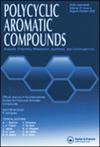In2O3 纳米粒子:一种用于 1,8-dioxo-octa-hydro Xanthene 衍生物绿色合成的可重复使用的环保型纳米催化剂
IF 2.4
3区 化学
Q2 CHEMISTRY, ORGANIC
引用次数: 0
摘要
实验室采用水热法合成了一种新颖、独特、可重复使用的 In2O3 纳米催化剂。通过傅立叶变换红外光谱(FT-IR)等特定方法对 In2O3 催化剂进行了表征,以研究 In2O3 催化剂中存在的官能团。能量色散 X 射线光谱(EDS)用于分析催化剂的元素组成。扫描电子显微镜 (SEM) 用于观察催化剂的微观形态。X 射线衍射图谱 (XRD) 用于确定催化剂的晶体结构,数据分析证实了 In2O3 催化剂晶体相的形成。利用合成的 In2O3 催化剂合成了 1,8-dioxo-octa-hydro xanthene 衍生物,在 15 分钟的工作时间内,产率达到 94%,这使其成为未来合成反应中一种具有成本效益和可持续性的选择。总之,这种新型 In2O3 纳米催化剂的合成及其在 1,8-dioxo-octa-hydro xanthene 衍生物合成中的成功应用,凸显了绿色化学方法在开发高效、环保化学工艺方面的潜力。本文章由计算机程序翻译,如有差异,请以英文原文为准。
In2O3 Nanoparticles: An Ecofriendly and Reusable Nano-Catalyst for Green Synthesis of 1,8-dioxo-octa-hydro Xanthene Derivatives
A novel, singular, and reusable In2O3 nanocatalyst was synthesized in the laboratory using a hydrothermal process. The In2O3 catalyst was characterized via specific strategies like Fourier transform infrared (FT-IR) was used to study the functional groups present in the In2O3 catalyst. Energy-dispersive X-ray spectroscopy (EDS) was used to analyze the elemental composition of the catalyst. A scanning electron microscope (SEM) was used to observe the morphology of the catalyst at a microscale level. X-ray diffraction pattern (XRD) was used to determine the crystal structure of the catalyst, and data analysis confirmed the formation of the crystalline phase of the In2O3 catalyst. The synthesized In2O3 catalyst was used for the synthesis of 1,8-dioxo-octa-hydro xanthene derivatives with 94% yield within 15 min of workup, this makes it a cost-effective and sustainable option for future synthesis reactions. Overall, the synthesis of this novel In2O3 nanocatalyst and its successful application in the synthesis of 1,8-dioxo-octa-hydro xanthene derivatives highlights the potential of green chemistry approaches in developing efficient and environmentally friendly chemical processes.
求助全文
通过发布文献求助,成功后即可免费获取论文全文。
去求助
来源期刊

Polycyclic Aromatic Compounds
化学-有机化学
CiteScore
3.70
自引率
20.80%
发文量
412
审稿时长
3 months
期刊介绍:
The purpose of Polycyclic Aromatic Compounds is to provide an international and interdisciplinary forum for all aspects of research related to polycyclic aromatic compounds (PAC). Topics range from fundamental research in chemistry (including synthetic and theoretical chemistry) and physics (including astrophysics), as well as thermodynamics, spectroscopy, analytical methods, and biology to applied studies in environmental science, biochemistry, toxicology, and industry. Polycyclic Aromatic Compounds has an outstanding Editorial Board and offers a rapid and efficient peer review process, as well as a flexible open access policy.
 求助内容:
求助内容: 应助结果提醒方式:
应助结果提醒方式:


